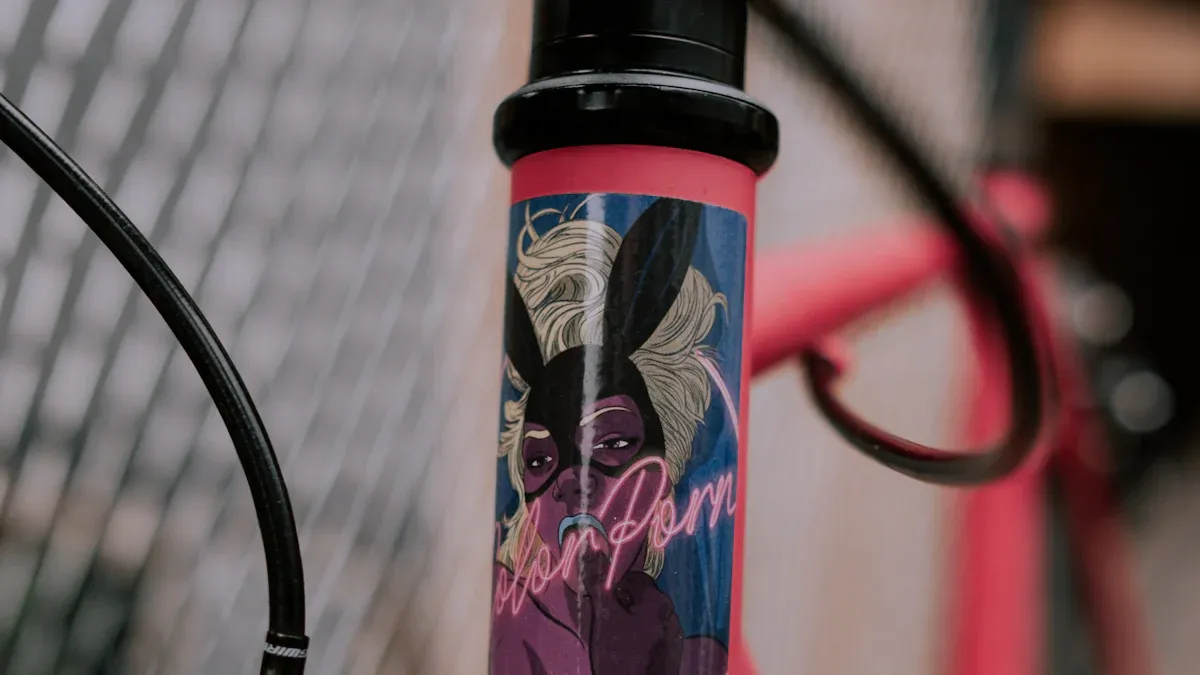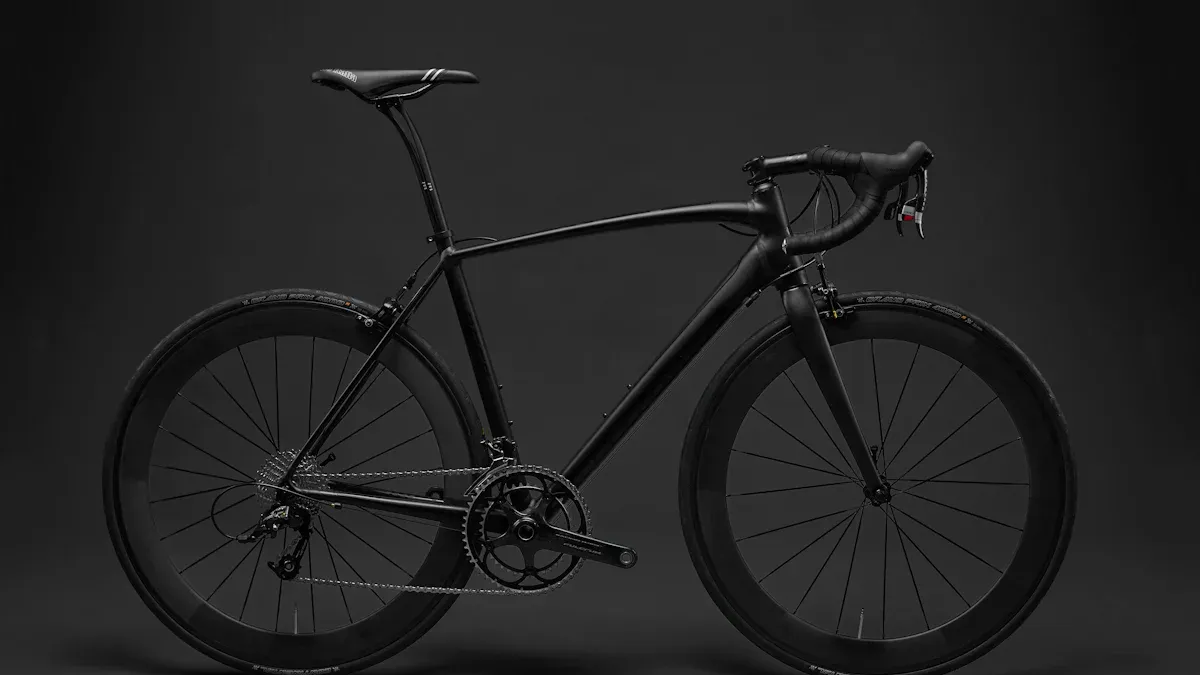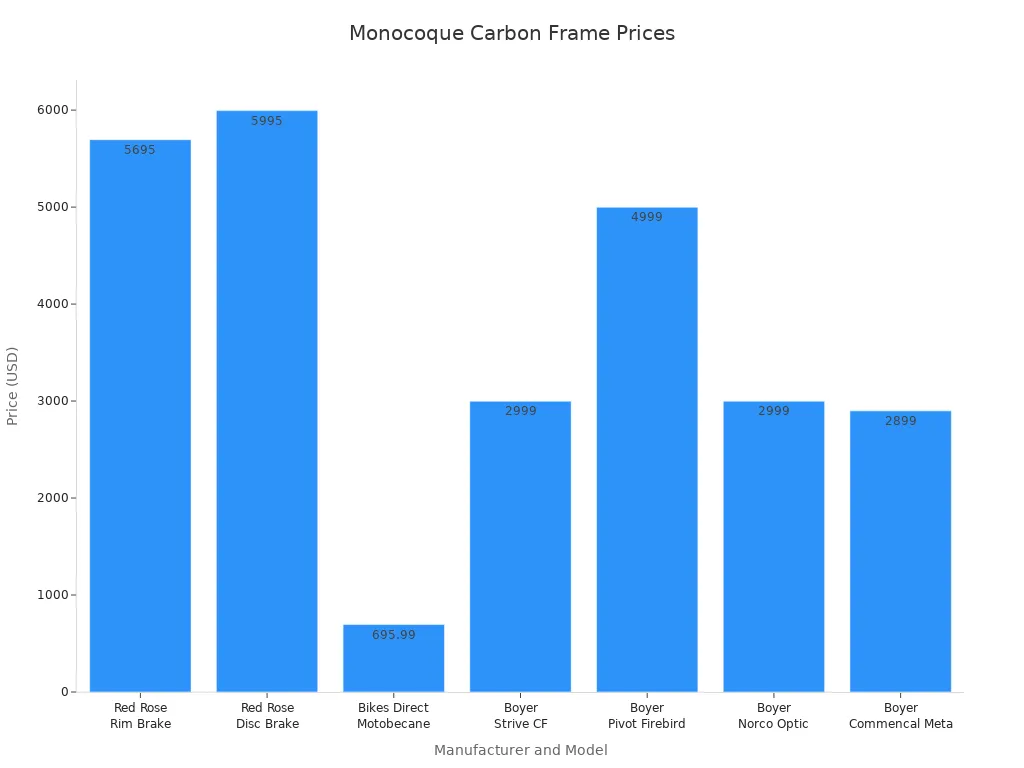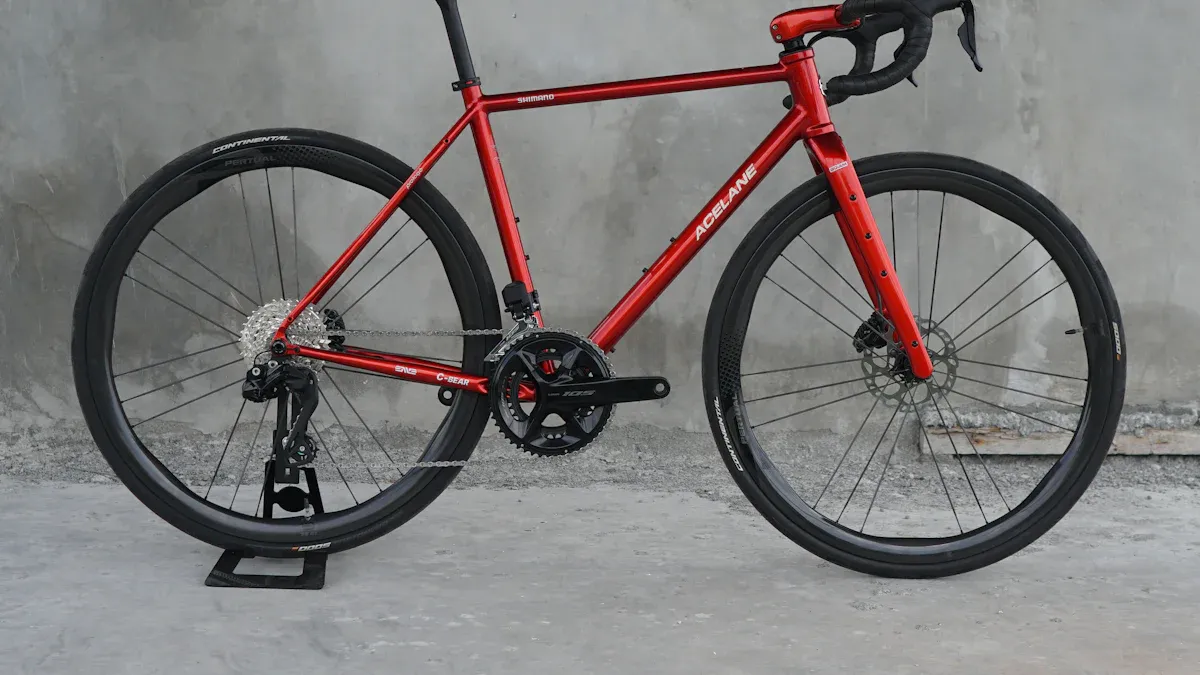
Choosing the right bike frame affects your cycling experience a lot. Each type of frame has its own benefits and downsides. The monocoque carbon bike frame has a smooth design. Lugged frames have separate parts that are connected. You might ask which choice is better for performance, cost, and looks. Knowing these differences can help you decide what fits your riding style best.
Key Takeaways
Monocoque carbon bike frames are lighter and more aerodynamic. This makes them great for serious cyclists who want speed and performance.
Lugged carbon bike frames let you customize your bike more. This helps riders make their bikes fit their needs and likes.
Monocoque frames usually cost more, but they give better long-term value for riders focused on performance.
Lugged frames are better for ride quality. They give a comfortable experience on bumpy roads, which is good for casual riders.
Think about your riding style and budget when picking between monocoque and lugged frames. This will help you choose the best option for you.
Monocoque Carbon Bike Frame

Construction Overview
Monocoque carbon bike frames have a special way of being made. This method creates one solid piece instead of using different parts. Here are the main steps to make a monocoque carbon bike frame:
Layer carbon in a metal mold.
Press the layers to let resin flow.
Put the parts together and heat them in an oven.
Use different layer amounts for each frame section.
The materials used to build these frames include:
Carbon fiber
Resins
Advanced composites
High modulus fiber
Boron fiber
These materials help make the frame strong and perform well. The mix of carbon fiber and resin makes a light but tough structure, perfect for fast bikes.
Performance Insights
Monocoque carbon bike frames do really well in many important areas. They go through tough tests to make sure they are strong and stiff. For example, tests like FE direct transient analysis mimic impacts to check how durable they are. The results show these frames are better than many others in weight and ride quality.
Testing Method | Purpose |
|---|---|
FE direct transient analysis | Mimics impact tests to check frame durability and performance. |
ISO4210 standards | Gives a way to evaluate performance in specific impact situations. |
Stiffness testing during production | Finds problems in the frame layers to ensure quality before finishing the frames. |
Destructive testing | Checks the overall quality of produced frames. |
Comparison of stiffness to weight | Shows how carbon fibers are better than metals, improving performance. |
In professional races, the bike frame’s weight really affects how well you perform. Monocoque carbon frames are made for aerodynamics, which is very important in racing. They have the right stiffness, so you can push harder during sprints. Plus, the comfort of carbon frames helps lessen tiredness during long races, allowing steady performance throughout the event.
Frame Type | |
|---|---|
Carbon | 20-40 |
Aluminum | 48 (52 with paint) |
Steel | 61 (65 with paint) |
Overall, the monocoque carbon bike frame is known for being light and having great performance features, making it a favorite among serious cyclists.
Lugged Carbon Mountain Bikes
Construction Overview
Lugged carbon mountain bikes are built in a special way. This method mixes strength with flexibility. First, you plan carefully. You research the bike’s shape and draw the design. This helps make sure the frame fits your needs. Next, you cut the tubes after doing some math, fixing any mistakes that come up.
Then, you make carbon fiber tubes. This means soaking sheets in epoxy and shaping them. After that, you join steel parts together and heat them to make them stronger. The next step is to attach these steel parts to the carbon tubes using strong glue. This glue holds well for mountain biking.
To make sure the glue covers everything, you use a bond line controller. Finally, you put together the lower tubes, starting from the head tube to the dropouts, checking for accuracy as you go. This careful building method makes a bike frame that is both light and strong.
In making lugged frames, companies often use composite fiber tubes connected to composite fiber lugs. These lugs are made of layers of carbon fibers mixed with epoxy resin. This mix shows the best materials that improve how lugged carbon mountain bikes perform.
Performance Insights
For performance, lugged carbon mountain bikes do really well in many areas. They give a ride quality that many cyclists love. The mix of carbon and metal lugs gives a good balance of stiffness and comfort. This means you can ride on rough paths while still feeling comfortable.
Tests show that strong carbon frames can do better than old steel frames. For example, a 1997 Trek OCLV carbon frame handled more stress than a 1997 lugged Columbus SLX frame. This shows that lugged carbon mountain bikes can take on tough rides and rough trails.
When it comes to weight, lugged carbon frames are usually a bit heavier than monocoque ones. But they often let you customize them more. You can change the shape to fit your riding style, making them popular with riders who like to personalize their bikes.
Aerodynamically, lugged carbon frames might not be as sleek as monocoque ones. But they still perform well, especially for riders who care more about comfort and ride quality than just speed.
Overall, lugged carbon mountain bikes are a great choice for cyclists who want strength, customization, and a good ride. Whether you are on trails or tricky paths, these frames can make your biking experience better.
Monocoque Advantages
Weight Benefits
Choosing a monocoque carbon bike frame gives you big weight benefits. These frames are usually lighter than lugged ones. A lighter bike frame can help you ride better. For example, a 1 kg difference in weight might seem small, but it can change your speed. But remember, making the bike more aerodynamic often helps more than just losing weight.
Key Points:
Lighter frames help you speed up faster.
A strong strength-to-weight ratio means you get toughness without extra weight.
Aerodynamic Efficiency
Monocoque carbon bike frames are great for being aerodynamic. Their shape reduces air resistance, which is important for racing. Wind tunnel tests show these frames can really boost your speed and efficiency. Here’s a look at the aerodynamic benefits:
Aerodynamic Advantage | Description |
|---|---|
Reduced Drag | Monocoque carbon frames are made to cut down air resistance, helping speed and efficiency. |
Optimized Airflow | The frame shapes guide airflow smoothly, cutting down turbulence around the bike. |
Kamm Tail Profiles | These frames use special shapes that keep them aerodynamic while being lighter. |
Integrated Cockpits | Features like built-in handlebars and cable routing help reduce drag and look good. |
Dynamic Testing | Companies use wind tunnels and simulations to improve designs for real-world performance. |
Rider-First Aerodynamics | Designs fit your riding position, greatly lowering overall drag. |
By focusing on weight and aerodynamics, monocoque frames give you an advantage. Brands like Trek and Specialized use this technology, making bikes for serious riders. If you want speed and efficiency, a monocoque carbon bike frame is a great pick.
Monocoque Disadvantages
Cost Factors
If you think about getting a monocoque carbon bike frame, be ready to spend a lot. These frames usually cost more than other types. Making them uses special methods and materials, which raises the price. Here are some common prices from well-known brands:
Model | Price | |
|---|---|---|
Red Rose Imports | Rim Brake Frameset | $5695 |
Red Rose Imports | Disc Brake Frameset | $5995 |
Bikes Direct | Motobecane Immortal Spirit | $695.99 |
Boyer Cycling | Strive CF | $2999 |
Boyer Cycling | Pivot Firebird | $4999 |
Boyer Cycling | Norco Optic C | $2999 |
Boyer Cycling | Commencal Meta AM V4 | $2899 |

As you can see, prices can be very different. Some models are cheaper, but many high-end ones can go over $5,000. This can be too much for many riders, especially beginners or those on a budget.
Fit Limitations
Another downside of monocoque frames is that they have fewer fitting choices. These frames usually come in less sizes than lugged frames. The bladder molding method used to make them needs costly molds, which limits how much you can customize.
Custom Fitting Options | Fabrication Method | Limitations | |
|---|---|---|---|
Monocoque | Limited sizes | Bladder molded, requires expensive molds | May not fit all riders well |
Lugged | More sizes available | Bonded construction, easier to customize | Less aerodynamic shaping options |
If you have special body sizes or riding styles, it might be hard to find a good fit with a monocoque frame. This can affect your overall performance and comfort while riding.
Lugged Advantages

Customization Potential
Lugged carbon bike frames are great for customization. You can change every part of your bike to fit your needs. Here are some important customization points:
Customization Aspect | Description |
|---|---|
Artisanal Approach | Each bike is made by hand, designed for your needs and measurements. |
Tube Selection | No standard tubes are used; every tube is chosen based on weight, handling, and stiffness. |
Fork Options | You can pick carbon fiber forks or have a custom steel fork made. |
Customization Limits | There are almost no limits on what can be changed in these fully-custom designs. |
This level of personalization helps you create a bike frame that matches your riding style. Many riders feel that a custom fit improves their experience and makes them happier. One cyclist said, > “I like suspension over hardtails. But the Seven Sola hardtail I’ve been riding for a year is my favorite bike ever. Why? It fits me perfectly and rides just how I like. It makes me happy, riding is fun, and I love it.”
Ride Quality
For ride quality, lugged carbon frames often do better than monocoque ones. The mix of carbon and metal lugs gives a good balance of stiffness and comfort. Here are some reasons why lugged frames are better in this area:
Kirk Frames says that steel gives a good mix of stiffness and resistance to wear, allowing for smaller tubing, which greatly affects ride quality.
Using brazed joints in lugged frames means less heat is used compared to welding. This creates a smaller heat-affected area and allows for thinner tubing, improving ride quality.
A study from UC Davis found that well-soldered lugged joints are stronger than welded or brazed ones. This means lugged frames might perform better and last longer, giving a better ride experience.
Overall, if you care about customization and ride quality, a lugged carbon bike frame is a great choice. These frames let you build a bike that fits you perfectly and provide a comfortable ride on different terrains.
Lugged Disadvantages
Weight Considerations
If you pick a lugged carbon bike frame, it will usually be heavier than a monocoque frame. This extra weight can change how well you perform, especially when racing or climbing hills. A heavier bike can slow you down and make it harder to speed up.
Weight Comparison:
Lugged Frames: Usually weigh more because of the extra materials in the lugs.
Monocoque Frames: Generally lighter since they are made from one piece of carbon.
If you care about speed and quick movements, a lugged frame might not be right for you. But if you like a stable ride on bumpy paths, the extra weight can help with control.
Aesthetic Variability
Another downside of lugged carbon bike frames is how they look. Some riders like the unique style of lugged frames, but others may think they look less nice than the smooth design of monocoque frames. The visible joints and lugs can give a more classic look, which some people might not like.
“I love the classic look of my lugged bike, but I know some prefer the modern style of monocoque frames.”
Customization can also make the look different. Different builders might use various colors and finishes, leading to a bike that looks different from what you wanted. If you want a bike that looks sleek, a monocoque frame might be a better choice.
Cost Comparison
Initial Costs
When you think about buying a bike frame, the starting cost is very important. Monocoque carbon bike frames usually cost more. This is because of the special way they are made and the materials used. Prices can be from $2,000 to over $5,000 for top models. Brands like Trek and Specialized are known for their high-quality bikes.
On the other hand, lugged carbon bike frames usually cost less. You can find good options starting at about $1,500. If you want to customize them, the price might go up, but they are still often cheaper than monocoque frames. Brands like Surly and All-City have great choices for people who want a good mix of cost and performance.
Long-term Value
Long-term value is also very important to think about. Monocoque frames often give better performance and last longer. Their light design can make your ride better, especially in races. If you plan to race or ride a lot, getting a monocoque frame might be worth it in the end. You could save money on repairs because they are built strong.
Lugged frames are usually heavier, but they let you customize and feel comfortable. If you like to change your bike, a lugged frame can make your ride more enjoyable. Just remember, the extra weight might slow you down over time. If comfort and ride quality matter more than speed, a lugged frame could be a smart choice.
Aesthetic Appeal
Visual Differences
When you look at bike frames, you see clear visual differences between monocoque and lugged designs. Monocoque frames usually have a smooth and sleek look. Their one-piece design gives them a modern feel. On the other hand, lugged frames show visible joints and lugs. This style can give a classic or vintage vibe.
Different areas and types of cycling affect how you see these styles. For instance, mountain bikers might like bright colors and graphics that show their adventurous side. Road cyclists may prefer simpler designs that focus on speed and aerodynamics. Here are some important points about visual differences:
Shape: Monocoque frames often have smooth shapes, while lugged frames can have more traditional outlines.
Color: You can find monocoque frames in bright colors, while lugged frames may have a mix of classic and modern shades.
Graphics: Monocoque designs often have simple graphics, while lugged frames may show detailed artwork.
Personal Preferences
Your personal style is very important when picking a bike frame. Looks matter because they help you connect with your bike. Designers know this and make frames that match different tastes. You can find choices that go from bold and bright to classic and subtle.
Think about what you like best. Do you enjoy the modern style of a monocoque frame, or do you admire the craftsmanship of a lugged frame? Your choice might also depend on current trends in fashion and sports. Many cyclists want bikes that not only work well but also look great.
In the end, the bike frame you choose should match your personality and riding style. Whether you like sleek designs or classic looks, there’s a bike frame that fits your vision.
In conclusion, you found out that monocoque and lugged carbon bike frames have different pros and cons. Monocoque frames are lighter and more aerodynamic, which is great for serious cyclists. However, they usually cost more. On the flip side, lugged frames provide customization and comfort, which is good for riders who want a perfect fit. If you want speed and performance, think about getting a monocoque frame. If comfort and customization matter more to you, a lugged frame might be a better choice.
FAQ
What is a monocoque bike frame?
A monocoque bike frame is made from one piece of material, usually carbon fiber. This design makes it stronger and lighter. It is great for racing and high-performance cycling.
How does a lugged bike frame differ from a monocoque frame?
A lugged bike frame has separate tubes that are connected by lugs. This design allows for customization and can give a more comfortable ride. However, it might be heavier than a monocoque frame.
Are monocoque frames worth the higher price?
Yes, if you care about performance and saving weight. Monocoque frames usually have better aerodynamics and stiffness. This makes them good for serious cyclists. But think about your budget and riding style before you decide.
Can I customize a lugged bike frame?
Definitely! Lugged bike frames let you customize a lot. You can pick tube shapes, materials, and colors to make a bike that fits your needs and style.
Which frame is better for beginners?
For beginners, a lugged bike frame might be better. It offers comfort and customization options, making it easier to find a good fit. Monocoque frames are great for performance but can be more expensive and less forgiving in terms of fit.
See Also
Evaluating Carbon Race Bike Frames For Optimal Performance
Understanding Carbon, Aluminum, And Steel Bike Frames For Shoppers
Distinguishing Between Fat Bike Frames And Mountain Bikes
Exploring The Innovations In Carbon Fiber Bike Frame Design
Transitioning From Lugged Steel To Modern Mountain Bike Frames
